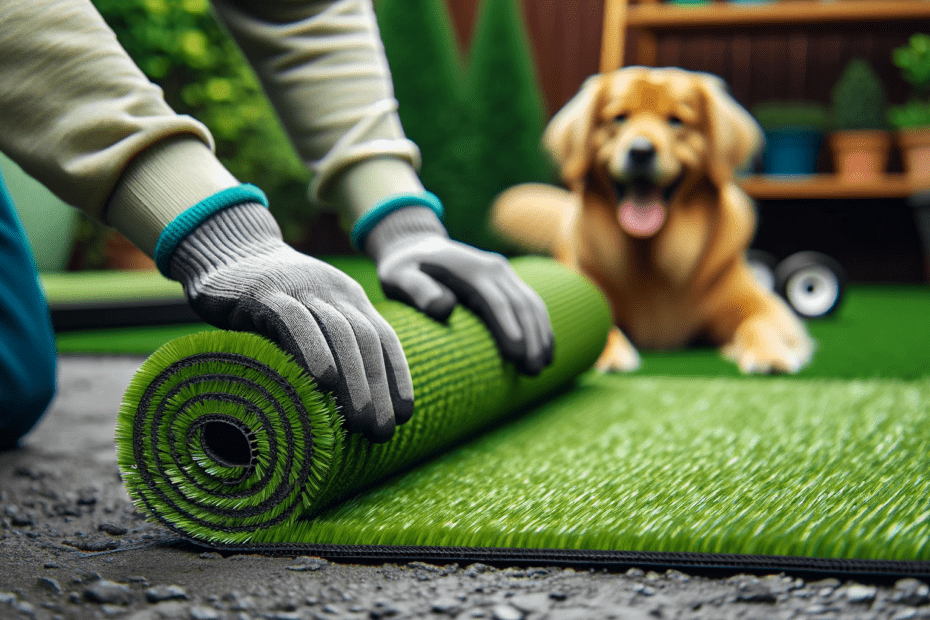Installing artificial grass for dogs can be a practical and effective solution to creating a low-maintenance and pet-friendly yard. In this step-by-step guide, we will walk you through the process of installing artificial grass, from measuring and prepping your yard to laying and securing the grass.
With our detailed instructions, you will be able to create a level and durable surface that is perfect for your furry friends to play and relax on.
Key Takeaways
- Prepare the area by removing existing grass and vegetation, adding a layer of crushed stone or sand, installing a weed barrier fabric, and leveling the ground for proper drainage.
- Choose pet-friendly artificial grass with excellent drainage capabilities.
- Lay and secure the artificial grass by unrolling it over the compacted crushed stone, trimming and shaping the edges, and securing them using landscape staples or nails.
- Maintain and clean the artificial grass regularly by removing debris, brushing the fibers, rinsing the surface occasionally, and using deodorizers or baking soda to prevent odors.
Measure and Prep Your Yard
To begin the process of installing artificial grass for dogs, you should first measure and prepare your yard. This step is crucial as it ensures that you have the right amount of artificial grass and that your yard is ready for installation.
The first thing you need to do is measure your yard accurately. Start by sketching a diagram of your yard, including any existing features such as trees or flower beds. Measure the length and width of your yard using a tape measure, and note down any irregularities or odd-shaped areas. This will help you determine the amount of artificial grass you will need to purchase.
Next, you need to prepare the soil in your yard. Remove any existing grass or vegetation by using a shovel or a turf cutter. It is important to remove the top layer of soil as well, as this will help create a level surface for your artificial grass. After removing the grass and soil, you may need to add a layer of crushed stone or sand to create a stable base for the artificial grass.
Once the soil is prepared, it is time to choose the right artificial grass for your dog. Look for artificial grass specifically designed for pets, as this usually has a higher drainage capacity and is more durable. Consider the pile height, density, and color of the grass to ensure it meets your aesthetic preferences and practical needs.
Remove Existing Grass and Debris
Before proceeding with the installation, it is imperative to diligently and regularly remove any existing grass and debris from the designated area. This step is crucial for proper yard preparation and weed control, ensuring a clean and smooth surface for the artificial grass to be installed.
To begin, gather the necessary tools for the job, including a spade or shovel, a rake, and a wheelbarrow or garbage bags for debris disposal. Start by using the spade or shovel to cut and remove the existing grass. Dig down to a depth of at least 2-3 inches, ensuring you remove all the grass roots and any other vegetation.
Next, use the rake to collect all the loose grass and debris from the area. Make sure to rake thoroughly, reaching into corners and along the edges. It is important to remove any rocks, stones, or other objects that could cause unevenness or discomfort to your dogs.
Once all the grass and debris have been removed, dispose of them properly in the wheelbarrow or garbage bags. Do not leave them on the ground, as they can hinder the installation process and affect the final outcome.
Install a Weed Barrier
Installing a weed barrier is an important step in the process of installing artificial grass for dogs. A weed barrier helps prevent weeds from growing through the turf and keeps the area looking neat and clean.
When installing the weed barrier, make sure to properly measure and cut the fabric to fit the area. This ensures that there are no gaps where weeds can penetrate the barrier.
Once the fabric is cut, secure it in place using landscape staples or adhesive. This will ensure that the weed barrier remains in place, even during heavy rain or wind.
Importance of Weed Barrier
One key step in the installation process of artificial grass for dogs involves the use of a weed barrier. Installing a weed barrier is essential for effective weed control and preventing pet accidents on the artificial turf.
A weed barrier is a layer of material that is placed between the soil and the artificial grass to prevent weed growth. It acts as a barrier, preventing weeds from penetrating through the turf and ruining the appearance of the lawn.
Additionally, a weed barrier helps to keep the artificial grass clean and hygienic, reducing the risk of pet accidents and unpleasant odors. By installing a weed barrier, you can ensure that your artificial grass remains weed-free, providing a safe and enjoyable outdoor space for your furry friends.
Proper Installation Techniques
To ensure a successful installation of the weed barrier, it is crucial to carefully follow proper techniques for installing artificial grass for dogs.
One of the first steps in the installation process is soil preparation. Start by removing any existing grass, weeds, and debris from the area where the artificial grass will be installed. Level the soil and fill any low spots to create a smooth surface.
Next, choose the right type of artificial grass for dogs. Look for a pet-friendly option that is specifically designed to withstand the wear and tear caused by dogs. It should have a durable backing and be able to drain efficiently.
Once the soil is prepared and the appropriate artificial grass is selected, it is time to lay down the weed barrier. This barrier will prevent weeds from growing through the artificial grass and provide an additional layer of protection for the surface. Roll out the weed barrier and secure it in place using landscape staples or adhesive. Make sure to overlap the edges and cut any excess material.
Following these proper installation techniques will help ensure a long-lasting and dog-friendly artificial grass surface.
Create a Level Base
To create a level base for the artificial grass, it is important to employ proper soil compaction techniques. This involves compacting the soil evenly and uniformly to ensure a stable and even surface.
Additionally, proper drainage considerations should be made to prevent water accumulation and potential damage to the artificial grass.
Soil Compaction Techniques
Proper soil compaction is essential for creating a stable and level base when installing artificial grass for dogs. Before beginning the compaction process, it is important to conduct a soil test to determine its composition and characteristics. This will help determine the appropriate compaction method and equipment needed. Soil testing can be done by collecting soil samples from various locations on the site and sending them to a laboratory for analysis.
Once the soil testing is complete, the next step is to choose the appropriate compaction equipment. This may include a vibratory plate compactor or a roller compactor, depending on the size and type of the area to be compacted. The equipment should be selected based on the soil type and its moisture content.
To achieve proper soil compaction, start by removing any rocks, debris, or vegetation from the area. Then, use the compaction equipment to compact the soil in layers. It is important to follow the manufacturer’s instructions for the specific equipment being used.
During the compaction process, it is essential to ensure that the soil is evenly compacted and free from any soft spots or voids. This can be achieved by making multiple passes with the compaction equipment, gradually increasing the compaction force with each pass.
Proper Drainage Considerations
When considering proper drainage for the installation of artificial grass for dogs, it is important to focus on creating a level base. This is crucial to ensure effective water runoff and prevent any pooling or waterlogging issues.
To achieve this, follow these steps:
- Clear the area: Remove any existing vegetation, rocks, or debris from the site. This will help create a smooth and even surface.
- Excavate the soil: Dig out the area to a depth of around 4 inches. This will allow space for the necessary layers of material.
- Install a geotextile membrane: Lay down a geotextile membrane over the excavated area. This will help prevent weeds from growing through the artificial grass and aid in drainage.
- Add a base layer: Apply a layer of crushed stone or gravel to create a stable and permeable base. This will allow water to drain easily and prevent the formation of puddles.
- Compact the base: Use a plate compactor to firmly compact the base layer. This will ensure stability and proper drainage.
By creating a level base with proper drainage solutions, you can ensure that your artificial grass installation for dogs remains clean, dry, and free from any water-related issues.
Choose the right artificial grass options that are designed specifically for pet use and that offer excellent drainage capabilities.
Lay and Secure the Artificial Grass
What is the best method for laying and securing artificial grass for dogs? When it comes to artificial grass installation for dog-friendly landscaping, proper laying and securing techniques are crucial to ensure a durable and safe surface for your furry friends. Here is a step-by-step guide to help you achieve the best results:
- Prepare the area:
Start by removing any existing grass, weeds, or debris from the designated area. Level the ground and ensure proper drainage to prevent water pooling.
- Install a weed barrier:
Lay a weed barrier fabric over the prepared area. This will help prevent weed growth and ensure a clean and low-maintenance surface for your dogs.
- Add a layer of crushed stone:
Spread a layer of crushed stone evenly over the weed barrier. This will provide stability and improve drainage.
- Compact the crushed stone:
Use a compactor or tamper to firmly compact the crushed stone layer. This will create a solid base for the artificial grass.
- Roll out the artificial grass:
Carefully unroll the artificial grass over the compacted crushed stone. Ensure the grass fibers face the same direction for a uniform look.
- Trim and shape:
Use a utility knife to trim the edges and shape the artificial grass as needed to fit the designated area perfectly.
- Secure the edges:
Secure the edges of the artificial grass using landscape staples or nails. Place them approximately every 6 inches along the perimeter and within the center of the grass to keep it in place.
Following these steps will help you lay and secure the artificial grass properly, creating a dog-friendly landscaping solution that is both aesthetically pleasing and functional.
Trim and Shape the Edges
To achieve a clean and polished look, trim and shape the edges of the artificial grass using a utility knife. Edge finishing is an important step in installing artificial grass for dogs, as it gives the installation a professional and neat appearance. Follow these steps to ensure a precise and tidy finish.
- Start by carefully examining the edges of the installed grass. Look for any uneven or overhanging sections that need to be trimmed.
- Use a straight edge, such as a wooden plank or a level, to guide your utility knife. This will help you achieve straight and even cuts along the edges.
- Hold the knife at a slight angle and apply gentle pressure to cut through the turf. Be careful not to cut too deep and damage the base underneath.
- Trim any excess grass along the edges, ensuring that the cuts are smooth and seamless. Take your time to achieve a clean and professional finish.
- Once you have trimmed the edges, use a stiff brush to brush the fibers in an upward direction. This will help blend the trimmed edges with the rest of the grass.
Remember to use dog-friendly materials when installing artificial grass for dogs. Avoid using toxic adhesives or sharp materials that may harm your furry friends. By following these steps, you can achieve a beautiful and dog-friendly artificial grass installation with neatly trimmed and shaped edges.
Add Infill and Brush the Grass
After trimming and shaping the edges of the artificial grass, it is time to add infill and brush the grass to ensure proper installation and optimal performance for dogs. Infill is an important component of artificial grass installation as it helps to support the blades and provide stability. There are various infill options available, including silica sand, rubber granules, and organic infills such as cork or coconut fibers. The choice of infill depends on factors such as budget, desired surface firmness, and odor control.
To add infill, start by evenly spreading the chosen infill material across the artificial grass. Use a shovel or a spreader to distribute the infill evenly, making sure to reach all areas of the grass. It is recommended to apply the infill in layers and then use a power broom or a stiff-bristled brush to work it into the turf. This helps to ensure that the infill is properly distributed and reaches the base of the grass.
Once the infill has been added, it is important to brush the grass to help the blades stand upright and create a more natural appearance. Begin by using a stiff-bristled brush or a power broom to brush against the grain of the grass. This helps to lift the blades and remove any excess infill or debris. Then, brush the grass in the direction of the grain to create a smooth and uniform surface. Repeat this process regularly to maintain the appearance and performance of the artificial grass.
Maintain and Clean the Artificial Grass
Regular maintenance and cleaning are essential for preserving the quality and longevity of artificial grass used for dogs. By properly maintaining and cleaning the artificial turf, you can ensure that it remains safe, odor-free, and aesthetically pleasing for both you and your furry friend. Here are some practical steps to help you maintain and clean your artificial grass effectively.
- Remove debris: Regularly remove any leaves, twigs, or other debris from the surface of the artificial grass. You can use a leaf blower or a stiff brush to sweep away the loose debris.
- Brush the grass: Use a stiff brush to brush the grass fibers in the opposite direction. This helps to keep the blades upright and maintain the natural look of the grass.
- Rinse the turf: Occasionally, rinse the artificial grass with water to remove any dirt or pet waste. You can use a hose or a pressure washer on a low setting to ensure thorough cleaning without damaging the turf.
- Treat pet waste: Promptly remove solid waste from the artificial grass and dispose of it properly. For liquid waste, rinse the affected area with water and use a pet-friendly disinfectant to eliminate any odors.
- Prevent odors: To prevent odors, you can use artificial grass deodorizers or sprinkle baking soda on the surface of the turf. This will help to absorb any unpleasant smells.
Frequently Asked Questions
How Long Does It Take for the Artificial Grass to Settle and Look Natural After Installation?
After the installation of artificial grass for dogs, it generally takes around 1-2 weeks for the grass to settle and look natural. During this period, it is important to follow proper maintenance techniques to ensure the longevity and appearance of the grass.
Regular brushing, removing any debris or pet waste, and occasionally using a hose to rinse the grass can help maintain its natural look.
Additionally, choosing a high-quality artificial grass designed specifically for dogs is essential to ensure durability and comfort for your furry friend.
Can Dogs Dig Through or Damage the Artificial Grass?
Dogs and artificial grass can coexist if proper precautions are taken to prevent damage.
While artificial grass is designed to be durable, dogs may still attempt to dig through it. To prevent this, it is recommended to install a sturdy sub-base that is resistant to digging.
Additionally, providing dogs with alternative outlets for their digging instincts, such as designated digging areas or toys, can redirect their behavior away from the artificial grass.
Regular maintenance, such as removing any debris or waste promptly, can also help maintain the integrity of the artificial grass.
Is It Safe for My Dog to Use the Artificial Grass for Bathroom Needs?
When considering the use of artificial grass for your dog’s bathroom needs, it is important to assess its hygienic properties.
Artificial grass can be a convenient and sanitary option, as it is typically designed with drainage systems that allow for easy cleanup.
Additionally, the synthetic materials used in artificial grass are typically non-toxic and unlikely to cause allergies in dogs.
However, regular cleaning and maintenance are essential to ensure a safe and hygienic environment for your pet.
Will the Artificial Grass Get Hot in the Sun and Potentially Burn My Dog’s Paws?
Artificial grass for dogs is a popular choice for pet owners due to its low maintenance and durability.
However, concerns about the grass getting hot in the sun and potentially burning dogs’ paws have been raised.
While it is true that artificial grass can become hot in direct sunlight, high-quality products are designed to dissipate heat quickly, reducing the risk of burns.
It is advisable to choose artificial grass with a cooling technology or install shade structures to minimize heat absorption.
How Often Should I Clean and Disinfect the Artificial Grass to Prevent Odor and Bacteria Buildup?
To prevent odor and bacteria buildup on artificial grass for dogs, regular cleaning and effective disinfection are essential. The cleaning frequency depends on various factors, such as the number of dogs using the area and the amount of traffic it receives.
Generally, it is recommended to clean the grass at least once a week. Use a mild detergent and water to remove any visible dirt or debris.
For effective disinfection, consider using pet-safe disinfectants specifically designed for artificial grass. Follow the manufacturer’s instructions for best results.
Conclusion
In conclusion, installing artificial grass for dogs requires careful measurement and preparation of the yard. This includes the removal of existing grass and debris, installation of a weed barrier, and creating a level base.
Once the preparation is complete, the artificial grass can be laid and secured. Trimming and shaping the edges is also necessary for a neat and finished look.
After the installation, adding infill is important to provide cushioning and stability to the artificial grass. Regular maintenance and cleaning are also necessary to keep the grass looking and smelling fresh.
By following these steps, you can create a durable and comfortable space for your furry friends to enjoy.






